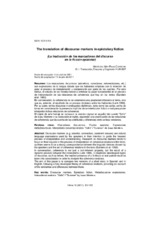Mostrar el registro sencillo del ítem
The translation of discourse markers in epistolary fiction
| dc.contributor.author | Rivas Carmona, M. del Mar | |
| dc.date.accessioned | 2020-01-22T11:15:10Z | |
| dc.date.available | 2020-01-22T11:15:10Z | |
| dc.date.issued | 2011 | |
| dc.identifier.issn | 1579-9794 | |
| dc.identifier.uri | http://hdl.handle.net/10396/19348 | |
| dc.description.abstract | Los marcadores discursivos (adverbios, conectores, reformuladores, etc.) son expresiones de la lengua natural que los hablantes emplean con la intención de guiar el proceso de interpretación y comprensión por parte de los oyentes. Por este motivo, el estudio de los mismos tiende a enfatizar su papel fundamental en el proceso de interpretación de las relaciones de coherencia que hay en los textos (Sanders et al. 1992). En conversación, la coherencia no es solamente una propiedad inherente al texto, sino que es, además, el resultado de un proceso dinámico entre los hablantes (Lenk 1998). Por su parte, en los discursos monologados diafónicos, tales como las cartas, se ha de tomar en consideración la presencia implícita de un interlocutor ficticio o real para poder interpretar dichas relaciones de coherencia. El objeto de este trabajo es comparar la versión original en español del cuento “Estío” de Isaac Montero y su traducción al inglés, siguiendo una clasificación de las relaciones de coherencia que da cuenta de las similitudes y diferencias entre ambas versiones | es_ES |
| dc.description.abstract | Discourse markers (e.g. adverbs, connectors, comment clauses) are natural language expressions used by the speakers in their intention to guide the hearers' process of interpretation and understanding. Research on discourse markers tends to focus on their key role in the process of interpretation of coherence relations within texts, as there seems to be a strong correspondence between the linguistic devices chosen by the speakers and the set of coherence relations in the texts (Sanders et al. 1992). In conversation, coherence is not just a text-inherent property, but the result of a dynamic process between the interactants (Lenk 1998). In diaphonic monological types of discourse, such as letters, the implied presence of a fíctitious or real partner must be taken into consideration in order to interpret the coherence relations. The aim of this paper is to compare two versions of a short story, in Spanish and in English, following a fully developed theory of coherence relations, providing an account of the similarities and differences between them | es_ES |
| dc.format.mimetype | application/pdf | es_ES |
| dc.language.iso | eng | es_ES |
| dc.publisher | UCOPress | es_ES |
| dc.rights | https://creativecommons.org/licenses/by-nc-nd/4.0/ | es_ES |
| dc.source | Hikma 10, 123-138 (2011) | es_ES |
| dc.subject | Marcadores discursivos | es_ES |
| dc.subject | Ficción epistolar | es_ES |
| dc.subject | Expresiones metadiscursivas | es_ES |
| dc.subject | Marcadores conversacionales | es_ES |
| dc.subject | “Estío” / “Summer” de Isaac Montero | es_ES |
| dc.subject | Discourse markers | es_ES |
| dc.subject | Epistolary fiction | es_ES |
| dc.subject | Metadiscursive expresiones. | es_ES |
| dc.subject | Interactional markers | es_ES |
| dc.subject | “Estío” / “Summer” by Isaac Montero | es_ES |
| dc.title | The translation of discourse markers in epistolary fiction | es_ES |
| dc.title.alternative | La traducción de los marcadores del discurso en la ficción epistolar | es_ES |
| dc.type | info:eu-repo/semantics/article | es_ES |
| dc.relation.publisherversion | https://www.uco.es/ucopress/ojs/index.php/hikma/index | es_ES |
| dc.rights.accessRights | info:eu-repo/semantics/openAccess | es_ES |

